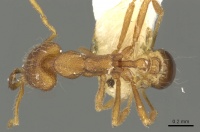Strumigenys nysu
| Strumigenys nysu | |
|---|---|

| |
| Scientific classification | |
| Kingdom: | Animalia |
| Phylum: | Arthropoda |
| Class: | Insecta |
| Order: | Hymenoptera |
| Family: | Formicidae |
| Subfamily: | Myrmicinae |
| Tribe: | Attini |
| Genus: | Strumigenys |
| Species: | S. nysu |
| Binomial name | |
| Strumigenys nysu Bolton, 2000 | |
The lone type was collected from sifted leaf-litter and log debris from a lowland wet forest.
Identification
Bolton (2000) - A member of the mayri complex in the Strumigenys mayri-group. See Strumigenys montu.
Keys including this Species
Distribution
Latitudinal Distribution Pattern
Latitudinal Range: -7.7° to -7.7°.
| North Temperate |
North Subtropical |
Tropical | South Subtropical |
South Temperate |
- Source: AntMaps
Distribution based on Regional Taxon Lists
Indo-Australian Region: New Guinea (type locality).
Distribution based on AntMaps
Distribution based on AntWeb specimens
Check data from AntWeb
Countries Occupied
| Number of countries occupied by this species based on AntWiki Regional Taxon Lists. In general, fewer countries occupied indicates a narrower range, while more countries indicates a more widespread species. |

|
Estimated Abundance
| Relative abundance based on number of AntMaps records per species (this species within the purple bar). Fewer records (to the left) indicates a less abundant/encountered species while more records (to the right) indicates more abundant/encountered species. |

|
Biology
Castes
Nomenclature
The following information is derived from Barry Bolton's Online Catalogue of the Ants of the World.
- nysu. Strumigenys nysu Bolton, 2000: 889 (w.) NEW GUINEA.
Unless otherwise noted the text for the remainder of this section is reported from the publication that includes the original description.
Description
Worker
Holotype. TL 2.0, HL 0.56, HW 0.38, CI 68, ML 0.26, MI 46, SL 0.36, SI 95, PW 0.22, AL 0.55. Characters of the mayri-complex. Preapical tooth spiniform, slightly longer than maximum width of mandible. Cephalic dorsum with 4-6 erect hairs along the occipital margin, the pair nearest the midline curved or narrowly looped apically; a simple pair present at level of highest point of vertex. Preocular notch strongly present; ventral surface of head with a broad shallow preocular transverse impression posterior to the broad and deeply incised postbuccal groove. Pronotal humeral hair flagellate, pronotum otherwise without erect hairs; mesonotum with one pair of erect flagellate hairs. Dorsal alitrunk reticulate-punctate but individual punctures shallower and more spaced out on pronotum. Dorsal surfaces of waist segments and first gastral tergite with flagellate hairs, those on the first gastral tergite erect and very long, sparse, restricted to a pair near the base and another pair near the apical margin. Katepisternum and most of metapleuron smooth, side of propodeum partially weakly punctulate. Propodeum armed with a pair of short straight spines, elevated at about 45°, not markedly upcurved, the length of one of which is equal to or slightly greater than distance separating their bases. Dorsal (outer) surface of hind basitarsus with 1-2 long erect flagellate hairs. Petiole in profile with anterior face of node slightly shorter than length of dorsum, in dorsal view petiole node as long as broad. Disc of postpetiole smooth, unsculptured except for a few extremely feeble short costulae at its anterior margin. In dorsal view basigastral costulae shorter than disc of postpetiole.
Paratype. TL 2.0, HL 0.58, HW 0.39, CI 67, ML 0.27, MI 47, SL 0.38, SI 97, PW 0.22, AL 0.56.
Type Material
Holotype worker, Papua New Guinea: Gulf Prov., Ivimka camp, Lakekamu Basin, 7.7°S, 146.8°E, 400 m., 20.xi.1996, #96-350, lowl. wet forest, sifted leaf litter and log debris (R. R. Snelling) (Los Angeles County Museum of Natural History). Paratype. One worker with same data as holotype (The Natural History Museum).
References
- Bolton, B. 2000. The ant tribe Dacetini. Memoirs of the American Entomological Institu (page 889, worker described)
References based on Global Ant Biodiversity Informatics
- Bolton, B. 2000. The Ant Tribe Dacetini. Memoirs of the American Entomological Institute 65
- Janda M., G. D. Alpert, M. L. Borowiec, E. P. Economo, P. Klimes, E. Sarnat, and S. O. Shattuck. 2011. Cheklist of ants described and recorded from New Guinea and associated islands. Available on http://www.newguineants.org/. Accessed on 24th Feb. 2011.

